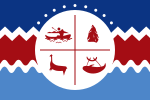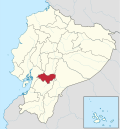The Omagua people (also known as the Umana, Cambeba, and Kambeba) are an indigenous people in Brazil's Amazon Basin. Their territory, when first in contact...
27 KB (3,601 words) - 06:27, 2 November 2024
Omagua is a Tupí-Guarani language closely related to Cocama, belonging to the Group III subgroup of the Tupí-Guaraní family, according to Aryon Rodrigues'...
7 KB (622 words) - 23:25, 29 December 2022
Samuel Fritz (category German Bohemian people)
among the Omaguas (Omayas or Cambebas) and within a few years had developed his own Omagua catechism in the Omagua language. The Omagua people had requested...
36 KB (4,426 words) - 10:20, 9 November 2024
"enormous towns of very rich people who possessed innumerable wealth". He was guided to a village of the Omagua people, and was told that the village...
56 KB (8,180 words) - 00:42, 8 November 2024
In the Americas, indigenous peoples comprise the two continents' pre-Columbian inhabitants prior to European settlement in the 15th century, as well as...
245 KB (24,779 words) - 02:47, 17 November 2024
Bible have been translated into the language. Cocama is closely related to Omagua, a nearly extinct language spoken in Peru and Brazil. Plosive sounds may...
7 KB (536 words) - 14:21, 30 September 2024
Secoya: Loreto, Peru/Ecuador Tupian peoples Tupí-Guaraní Tupi: Paraguay, Brazil, Bolivia, Peru and Argentina Cocama-Omagua Cocama-Cocamilla (Kokáma): Loreto...
162 KB (13,893 words) - 18:33, 24 November 2024
Timoto–Cuica people were an Indigenous people of the Americas composed primarily of two large tribes, the Timote and the Cuica, that inhabited in the Andes...
6 KB (518 words) - 04:57, 24 May 2024
of the Great Plains in the 16th century Unama people, more commonly known as Omagua, Indigenous peoples of South America. Umana Yana, a thatched hut conference...
719 bytes (134 words) - 02:53, 18 July 2024
Taíno (redirect from Taino people)
Indigenous people of the Caribbean, whose culture has been continued today by their descendants and Taíno revivalist communities. Indigenous people in the...
108 KB (12,220 words) - 13:07, 22 November 2024
Auatí-Paraná Extractive Reserve (section People)
in 30 October 2012. The original inhabitants of the region were the Omágua people, a Tupi-Guarani group. They were known for their fine ceramics and finely...
6 KB (614 words) - 08:06, 2 November 2024
also known as Camanchacos or Camanchangos, are an Indigenous people or group of peoples who inhabited a long stretch of the Pacific coast from southern...
10 KB (962 words) - 12:00, 30 October 2024
[pronunciation?] (contraction of Te' Inik, "people from here"; also known as Huaxtec, Wastek or Huastecos) are an indigenous people of Mexico, living in the La Huasteca...
18 KB (2,313 words) - 23:27, 22 September 2024
Pre-Cabraline history of Brazil (category Indigenous peoples in Brazil)
new language subgroups, such as the Cocama, Omágua, Guaiaqui, and Xirinó. The Cocama and Omágua peoples headed to the Amazon River, while the Guaiaqui...
67 KB (7,644 words) - 04:19, 22 April 2024
This is a list of the Brazil's Indigenous or Native peoples. This is a sortable listing of peoples, associated languages, Indigenous locations, and population...
34 KB (478 words) - 23:11, 10 November 2024
Brazil Nukak (Nukak-Makú), eastern Colombia Ocaina, Loreto Region, Peru Omagua (Cambeba, Kambeba, Umana), Amazonas, Brazil Orejón (Orejon), Napo Province...
31 KB (2,629 words) - 13:00, 29 August 2024
The peopling of the Americas began when Paleolithic hunter-gatherers (Paleo-Indians) entered North America from the North Asian Mammoth steppe via the...
133 KB (13,977 words) - 22:42, 23 November 2024
Population figures for the Indigenous peoples of the Americas before European colonization have been difficult to establish. Estimates have varied widely...
154 KB (10,953 words) - 01:52, 19 November 2024
The Pipil are an Indigenous group of Mesoamerican people inhabiting the western and central areas of present-day El Salvador. They are a subgroup of the...
36 KB (4,382 words) - 13:05, 2 November 2024
Shuar (redirect from Jivaro people)
belongs to the Jivaroan linguistic family and is spoken by over 50,000 people in the region. The Shuar are known for their skill in warfare, both in defending...
19 KB (2,366 words) - 14:40, 25 April 2024
Tlaxcaltec (redirect from Tlaxcaltec people)
The Tlaxcallans, or Tlaxcaltecs, are an indigenous Nahua people who originate from Tlaxcala, Mexico. The Confederacy of Tlaxcala was instrumental in overthrowing...
14 KB (1,287 words) - 14:36, 23 October 2024
Yagua (redirect from Yagua people)
in 1686 with the establishment of a Jesuit mission at San Joaquin de los Omagua, on an island in the Amazon river probably near what is now the mouth of...
9 KB (1,082 words) - 17:36, 15 January 2024
Mixtec (redirect from Mixtec people)
Mixtecs (/ˈmiːstɛks, ˈmiːʃtɛks/), or Mixtecos, are Indigenous Mesoamerican peoples of Mexico inhabiting the region known as La Mixteca of Oaxaca and Puebla...
92 KB (2,736 words) - 21:04, 2 October 2024
Beothuk (redirect from Beothuk people)
(/biːˈɒtək/ or /ˈbeɪ.əθʊk/; also spelled Beothuck) were a group of Indigenous people of Canada who lived on the island of Newfoundland. The Beothuk culture formed...
41 KB (4,689 words) - 11:55, 13 November 2024
Brazil Nukak (Nukak-Makú), eastern Colombia Ocaina, Loreto Region, Peru Omagua (Cambeba, Kambeba, Umana), Amazonas, Brazil Orejón (Orejon), Napo Province...
110 KB (9,030 words) - 13:21, 16 November 2024
Toltec (redirect from "Toltec people")
culture are unclear, it likely developed from a mixture of the Nonoalca people from the southern Gulf Coast and a group of sedentary Chichimeca from northern...
32 KB (3,671 words) - 03:54, 20 September 2024
Aztecs (redirect from Aztec people)
central Mexico in the post-classic period from 1300 to 1521. The Aztec people included different ethnic groups of central Mexico, particularly those groups...
169 KB (21,050 words) - 02:58, 24 November 2024
Lope de Aguirre (category 16th-century Spanish people)
the Amazon River in search of the mythical golden Kingdom El Dorado and Omagua. In 1561, Aguirre led a mutiny against the expedition's commander, Pedro...
20 KB (2,191 words) - 02:44, 27 October 2024
Muisca (redirect from Chibcha people)
Indigenous people and culture of the Altiplano Cundiboyacense, Colombia, that formed the Muisca Confederation before the Spanish conquest. The people spoke...
44 KB (4,920 words) - 21:11, 24 November 2024
Cañari (redirect from Canari people)
independent pre-Columbian tribal confederation of the same name. The historic people are particularly noted for their resistance against the Inca Empire. Eventually...
19 KB (2,354 words) - 16:43, 28 August 2024























